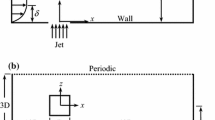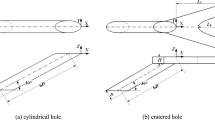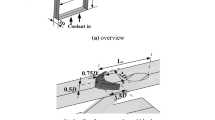Abstract
Computational analysis on film cooling effectiveness over a flat plate using different coolant injection hole geometries are reported. The designed computational setup and flow physics are suitably validated against the existing experimental results for an injection angle of 30°. The present study reports and compares the degree of film cooling effectiveness obtained by the different orientations of the coolant injection holes and their geometry, hole arrangements in the rows and number of rows. The computational domain was designed using Ansys Fluent. The blowing ratio is systematically ranged between 0.67 and 1.67. The performance of a given film cooling scheme is reported in terms of centreline (ηcl) and spatially averaged (ηsa) adiabatic effectiveness. It is observed that for single hole configuration, the semi-elliptic geometry increases the ηcl by ~66.67% up to x/D(ratio of downstream distance from hole to diameter of hole) = 50 at lower blowing ratios (0.67 and 1.00) and by ~50% up to x/D=100 at higher blowing ratios (1.33 and 1.67). For ηsa, an increment of ~200% and ~60% is achieved for all blowing ratios using the triangular and semi-elliptic geometries, respectively. For the multiple row arrangements, the two staggered rows delivered an increment in ηcl of ~77% up to x/D=50 and ~54% up to x/D=100. The two staggered configurations at 0° gave the highest effectiveness increment of ~177% up to x/D=50 while it was ~100% for up to x/D=100. Results indicate that the triangular geometry shows the highest values of the film cooling effectiveness, and a semi- elliptic geometry utilizes ~50% of the coolant mass flow than other coolant injection hole geometries while delivering higher effectiveness values.









Similar content being viewed by others
References
Li J, Yan X, He K and Goldstein R J 2021 Implementation of rectangular vortex generator pairs to improve film cooling effectiveness on transonic rotor blade endwall. J. Eng. Gas Turbines Power. 143(9): 091022
Wang N, Shiau C C, Han J C, Xu H and Fox M 2019 Turbine vane endwall film cooling from mid-chord or downstream rows and upstream coolant injection. Int. J. Heat Mass Transf. 133: 247–255
Azzi A and Jubran B A 2007 Numerical modelling of film cooling from converging slot-hole. Heat Mass Transf. 43(4): 381–388
Bunker R S 2005 A review of shaped hole turbine film-cooling technology. J. Heat Transfer. 127(4): 441–453
Goldstein R J, Eckert E R and Ramsey J W 1968 Film cooling with injection through holes: adiabatic wall temperatures downstream of a circular hole. J. Eng. Power. 90(4): 384–393
Yuen C H and Martinez-Botas R F 2003 Film cooling characteristics of a single round hole at various streamwise angles in a crossflow: Part I effectiveness. Int. J. Heat Mass Transf. 46(2): 221–235
Yuen C H and Martinez-Botas R F 2003 Film cooling characteristics of a single round hole at various streamwise angles in a crossflow: Part II: Heat transfer coefficients. Int. J. Heat Mass Transf. 46(2): 237–249
Chen P, Gao H, Li X, Ren J and Jiang H 2018 Effects of endwall 3D Contouring on film cooling effectiveness of cylindrical hole injections at different locations on vane endwall. In: Proceedings of the ASME Turbo Expo 2018: Turbomachinery Technical Conference and Exposition. Volume 5C: Heat Transfer. Oslo, Norway. 51104: V05CT19A031
Wang T and Li X 2008 Mist film cooling simulation at gas turbine operating conditions. Int. J. Heat Mass. Transf. 51(21–22): 5305–5317
Guangchao L, Huiren Z and Huiming F 2008 Influences of hole shape on film cooling characteristics with CO2 injection. Chinese J. Aeronaut. 21(5): 393–401
Dellimore K H, Marshall A W and Cadou C P 2010 Influence of compressibility on film-cooling performance. J. Thermophys. Heat Transf. 24(3): 506–515
Wright L M, McClain S T and Clemenson M D 2010 Effect of density ratio on flat plate film cooling with shaped holes using PSP. J. Turbomach. 133(4): 041011
Baheri S, Tabrizi S P and Jubran B A 2008 Film cooling effectiveness from trenched shaped and compound holes. Heat Mass Transf. 44(8): 989–998
Asghar F H and Hyder M J 2010 Computational study of film cooling effectiveness for a comparison of cylindrical, square and triangular holes of equal cross-sectional area. Mehran Univ. Res. J. Eng. Technol. 29(4): 541–556
Jindal P, Agarwal S, Sharma R P and Roy A K 2017 Numerical investigation of film cooling enhancement using staggered row mixed hole arrangements. J. Therm. Sci. Eng. Appl. 9(2): 021007
Shiau C C, Sahin I, Wang N, Han J C, Xu H and Fox M 2019 Turbine vane endwall film cooling comparison from five film-hole design patterns and three upstream injection angles. J. Therm. Sci. Eng. Appl. 11(3): 031012
Li J, Yan X and He K 2020 Effect of non-axisymmetric endwall profiling on heat transfer and film cooling effectiveness of a transonic rotor blade. J. Turbomach. 142(5): 051006
Bu H, Guo Z, Song L and Li J 2021 Effects of cooling configurations on the aerothermal performance of a turbine endwall with jet impingement and film cooling. J. Turbomach. 143(6): 061013
Funding
This research received no specific grant from any funding agency in the public, commercial, or not-for-profit sectors.
Author information
Authors and Affiliations
Corresponding author
Ethics declarations
Competing interest
The authors declare that they have no known competing financial interests or personal relationships that could have appeared to influence the work reported in this paper.
Rights and permissions
Springer Nature or its licensor (e.g. a society or other partner) holds exclusive rights to this article under a publishing agreement with the author(s) or other rightsholder(s); author self-archiving of the accepted manuscript version of this article is solely governed by the terms of such publishing agreement and applicable law.
About this article
Cite this article
Jindal, P., Naagar, M., Krishna, S.M.M. et al. CFD based parametric investigations of film cooling effectiveness for various coolant injection hole geometries and injection angles. Sādhanā 49, 158 (2024). https://doi.org/10.1007/s12046-024-02492-1
Received:
Revised:
Accepted:
Published:
DOI: https://doi.org/10.1007/s12046-024-02492-1




